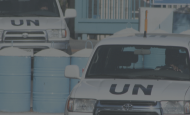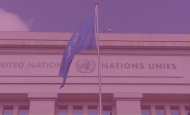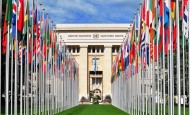Commission of Inquiry Round 4: Disinformation and Terrorism Denial
“Commissioners Pillay, Kothari, and Sidoti. I am very sorry to say you succeeded. Since the moment this Commission was set up, you have dedicated yourselves to excusing, justifying and downplaying Palestinian terror while demonizing and delegitimizing Israel’s efforts to defend itself. You sent a clear message to Hamas, to Palestinian Islamic Jihad, to Iran that they have little to fear on the international front. That the UN Human Rights Council and its open-ended Commission of Inquiry will do everything in their power to create moral equivalence, or rather immoral equivalence between a democracy defending itself while respecting international law and radical, bloodthirsty terrorist groups. Well, commissioners, Hamas got your message loud and clear.”
– Israel Ambassador to the United Nations Gilad Erdan, at the presentation of the COI’s report in October 2023
Introduction
On October 16, 2023, the UN Human Rights Council (UNHRC)’s permanent “Independent International Commission of Inquiry on the Occupied Palestinian Territory, including East Jerusalem, and in Israel” (COI) published its fourth report, purporting to analyze the “human rights and legal consequences of force used and identifying root causes of recurring violence and protracted conflict.” On October 24, the COI presented its report to the Third Committee at the 78th Session of the General Assembly.
In preparing its report, the COI relied heavily on Palestinian sources, including terror-linked non-governmental organizations (NGOs). The COI uncritically adopted the NGOs’ tendentious application of a domestic law enforcement paradigm to analyze violence – erasing the context of armed conflict with Hamas and other Palestinian terror groups.
The report, which covers May 2021 through July 2023, was not amended following the brutal October 7 pogrom by Hamas, when thousands of Palestinian terrorists poured across the border from Gaza into Israel, slaughtering 1400+ Jews, and torturing, maiming, and kidnapping others. However, the COI’s press release publicizing the report (October 16) minimized the atrocities, equated Israel with Hamas, and stated that the COI had “begun collecting evidence of war crimes committed by Hamas and other Palestinian armed groups and by Israeli security forces.” It offensively claimed, “Our report is painful and timely…It emphasises that the only path towards ending violence and achieving sustainable peace… requires addressing the root causes of the conflict, including the occupation of Palestinian territory.” Since its founding, the COI has placed sole blame for the conflict on Israel and erased genocidal antisemitism of Palestinian actors as a driving force of violence. In addition, the COI itself has repeatedly engaged in antisemitism.
As in previous publications, the Commission’s biased and one-sided approach, based largely on unverified accusations of politicized NGOs, ignores Palestinian rejectionism and terrorism – which is starkly evident in the Hamas Charter, ongoing incitement, and the October 7 massacre. By neglecting and erasing key aspects of the conflict, the Commission ultimately contributes to the continuation of violence.
Methodology
Reflecting the ongoing secrecy surrounding the COI, the report relies heavily on unverifiable, anonymous testimonies and politicized NGOs. It is unclear if and how the COI attempted to independently corroborate these sources and to what extent it engaged in any investigation beyond a narrow selection of source material and individuals confirming the COI’s predetermined conclusions.
According to the report, “The report is based on interviews conducted with primary and secondary sources up to 31 July 2023, open-source research, meetings with stakeholders, public hearings and submissions received following a call issued on 2 November 2022.”
Moreover, the COI claims that “Information that met the criteria of reliability and authenticity was included and analysed under the standard of proof of ‘reasonable grounds to conclude’.”
No interviewees or “stakeholders” are identified, nor did the COI detail how any of these individuals were selected or how their expertise was determined. No information is provided as to how the COI assessed the “reasonable grounds to conclude” standard. Moreover, while some sources are identified in the footnotes, in many instances, the report simply refers to “document on file” with no further identifying information.
Additionally, it appears that the COI ignored key witnesses and did not meet with stakeholders who did not promote anti-Israel or anti-Zionist viewpoints. It also appears that the COI did not make any attempt to engage with the individuals and organizations that made submissions to the COI from a perspective that was not overwhelmingly hostile to Israel. As a result of this biased methodology, the entire process clearly has no validity.
Unreliable Sources
The report contains little original research, but rather copies-and-pastes from previous UN attacks on Israel – which themselves are largely based on repeating distorted factual and legal claims from anti-Israel NGOs.
The COI cites and reiterates unverified claims by many politicized and biased NGOs including Amnesty International, Human Rights Watch, Al Mezan, Al-Haq, B’Tselem, Forensic Architecture, Defense for Children International – Palestine, Adalah, Jerusalem Legal Aid and Human Rights Center (JLAC), Médecins sans Frontières (Doctors Without Borders), and Save the Children. Some of these NGOs have ties to the Popular Front for the Liberation of Palestine (PFLP), a designated terrorist organization by the US, EU, Canada, and Israel. Many of these NGOs also promote the narrative that Israel is guilty of apartheid and commits war crimes. Almost all of these groups refuse to document or condemn Palestinian violations of human rights and international law. Those that have on occasion done so, do so solely in cursory, token fashion to blunt criticism of their on-going bias and lack of credibility.
Minimizing Israel’s Right to Self-Defense
The Commission minimizes and negates Israel’s right to self-defense against Palestinian terrorism, implying that terrorism is not a valid justification for Israel’s security concerns claiming that the term “is not clearly defined under international law.” The report places quotation marks around the word terrorism, terrorist, and terror every time it appears in the report, in order to belittle the term and discount Israel’s legitimate security measures.
In its conclusions, and without legal or factual basis, the Commission states that Israeli security measures are not justified and “rejects Israeli authorities’ use of pre-emption or deterrence as the legal basis justifying these actions.” By denying Israel’s right to self-defense against terrorism, the Commission ultimately emboldens and encourages terrorist organizations and violent acts against Israel, such as what occurred on October 7.
Whitewashing Palestinian Violence
The report glosses over mass acts of Palestinian violence by referring to them as “protests” or “demonstrations” that “assert their right to self-determination.” While the COI tries to illustrate these events as peaceful, the examples provided by the COI are quite the opposite. For example, the COI ignores the violent nature of the 2018 March of Return, which included Molotov cocktails, arson, and attempts to breach the border fence with Israel. It is clear now that the 2018 violence at the Gaza border were planning operations for Hamas’ invasion and massacre to test Israel’s defenses and response. Yet, the COI continues to erase Hamas’ violent and illegal aims. The April 2023 “protests” at the Al Aqsa mosques included Palestinians desecrating the mosque, barricading themselves inside, and throwing stones and fireworks at the Israeli police and Jewish worshippers. The May 2021 “demonstrations” involved Arabs targeting Jews and Jewish institutions (or what they thought to be Jewish homes), leading to a number of deaths. By erasing a central part of these incidents and most of the violations, the COI again displays their divisive agendas, in contrast to universal human rights values.
Additionally, the report admits that “some Palestinian protesters…have thrown stones at armed ISF during demonstrations,” but claims without foundation that it “understands most cases of stone-throwing in these contexts to be aimed at expressing protest, including as a result of Israeli security forces soldiers entering places of worship.” The report also falsely alleges that “Stone-throwing does not normally pose an imminent threat to the lives of heavily armed and armoured military forces.” A footnote plainly states, “The Commission is not aware of a single Israeli security forces soldier being killed as a result of stone-throwing”; however, a simple Google search reveals that an Israeli soldier was killed by thrown stones in the West Bank in May 2020 and a soldier was fatally injured when a heavy stone slab was thrown at his head in 2018. Stone throwing also poses a lethal threat to civilians, such as Asher Palmer and his 1-year-old son Yonatan who were murdered when Palestinians targeted their car and 2-year-old Adele Bitton.
By whitewashing these violent incidents as protests to “assert their right to self-determination,” the Commission legitimizes the violent behavior during these incidents.
Erasing Terrorist Casualties
When reporting casualties of strikes, the COI generally does not have independently verifiable information, relying instead on Hamas. In addition, it often conflates combatants and civilians. High casualty figures – either misidentifying terrorists as civilians or neglecting to mention the terrorist affiliations – create the appearance of wrongdoing by Israel. It also undermines the foundation of IHL which requires distinguishing between armed actors and civilians.
One of the case studies utilized by the COI is the July 2023 Jenin Operation. While the COI mentions that 12 people were killed, it neglects to mention that 10 of those were members of the Palestinian Islamic Jihad, Hamas, Fatah, and al-Aqsa Martyrs’ Brigades. During the funeral procession, the bodies were wrapped in Palestinian Islamic Jihad and Hamas flags. Following the withdrawal of Israeli troops, Hamas leader Ismail Haniyeh published a statement that “Palestinian resistance had taught a hard lesson to the enemy, and had made him suffer heavy losses.”
Additionally, when the COI discusses the May 2021 conflict, it mentions a count of how many Palestinians were killed, based on information provided to OCHA. As documented in detail by NGO Monitor, OCHA’s data comes from Hamas and unverified and unreliable claims of political advocacy NGOs, many of which are terror-linked, as well as claims by the PLO. These organizations regularly fail to implement best practices in fact checking and research methodology, lack legal and military expertise, and do not represent credible sources of information. For instance, while reporting on Israeli airstrikes, these NGOs acknowledged that they did not have “the evidence” that the “Israeli military … says it relied on to carry out these attacks.” Yet, they did not hesitate to make baseless pronouncements that Israel engaged in indiscriminate and disproportionate attacks.
NGOs also falsely classified Palestinian combatants as civilians and ignored evidence implicating Palestinian terror groups in the deaths of Gazan civilians. (Approximately 15 percent of the 4,300 missiles fired towards Israel in May 2021 fell short and impacted in Gaza.) NGO Monitor research has identified 50 incidents in which Hamas and Islamic Jihad operatives killed in Gaza were falsely labeled by NGOs as civilian casualties, or in which civilians killed by Hamas were implicitly attributed to Israel.
Gaza Blockade
The COI criticizes Israel for its security measures surrounding Gaza, falsely labeling it as “collective punishment,” and stating that “these incursions and attacks are directly linked to the larger context of the Israeli occupation and the blockade of Gaza.”
This is false as a legal matter and disingenuous and de-contextualized rhetoric – as acutely seen in the October 7 massacre and its aftermath. Firstly, while the COI makes token mention of the two decades of increasing rocket fire directed at Israeli population centers by “Palestinian armed groups,” though without referring to it as terrorism or constituting thousands of war crimes, it omits that the blockade was implemented in an effort to stop Palestinian terrorists from smuggling of weapons and rockets into Gaza that would later be used to target Israeli civilians. No honest assessment of Israeli policy can whitewash the threat that Gaza-based terror groups like Hamas and Islamic Jihad pose to Israeli citizens. All the more so after the massacre.
Secondly, the COI appears to be unaware of the UN’s 2011 Palmer Report, which found that “Israel faces a real threat to its security from militant groups in Gaza. The naval blockade was imposed as a legitimate security measure in order to prevent weapons from entering Gaza by sea and its implementation complied with the requirements of international law.”
The COI is similarly silent about complicity by UN agencies and humanitarian aid organizations with regards to diversion of aid by Hamas and the wholesale embedding of its weaponry and tunnel infrastructure within residential areas. This complicity also represents a significant breach of the humanitarian principles and operating agreements by which these actors are bound, but also of Security Council resolution 1373 and multiple other counter-terror laws both domestically and internationally. In addition, they are in violation of multiple IHL and human rights obligations.
Lastly, the COI ignores the culpability of multiple other international actors including Iran and Qatar. Moreover, it makes only perfunctory note of the fact that Gaza shares a border with Egypt, meaning that Israel does not control all passage in and out of the territory, despite it falsely claiming so in the report.
Proportionality and Use of Force
In the report, the COI accuses Israel of utilizing “unnecessary and disproportionate use of force” against individuals who did not “pose an imminent threat to life.” Under international law, a country has an unfettered right to defend its border from hostile attack. Additionally, the standard of “posed no imminent threat to life” is used in a law enforcement situation, not a paradigm of terrorism, armed conflict, and a hostile border confrontation.
Like many misnomers about international law and Israel, distortions regarding proportional responses to aggression are central to political advocacy campaigns that exploit legal rhetoric for demonization. As opposed to Palestinian rockets fired in large numbers toward population centers, which are unequivocal and undeniable war crimes, Israeli strikes against terror infrastructure in the West Bank and Gaza are legally justifiable. Even if there may be concerns about certain incidents, the issues are complex and intensely debated by international legal experts.
Moreover, without access to detailed information from the Israeli army about intelligence assessments and targeting, the COI cannot possibly conclude definitively that Israeli actions are illegal and “disproportionate.” For a UN committee to make legal and factual assertions outside of its area of competence and in the absence of verified knowledge is unprofessional, unethical, and a violation of the Committee’s mandate and UN rules.
The COI further does not indicate at what precise point the IDF should be able to use force, nor does it recommend what IDF “restraint” might look like. The COI regularly condemns Israel’s use of tear gas and other non-lethal methods of crowd control, indicating that any action taken by the IDF to defend against violence would have been deemed “excessive” by the COI.
The case study of Shireen Abu Akleh – a central piece of the COI report – illustrates the limitations of the COI and NGOs. Even if the evidence shows that an Israeli soldier fired the fatal shot, that does not mean the soldier acted unlawfully. Similar to their other pronouncements on war crimes, the COI and NGOs lack the credible research methodology necessary to draw credible conclusions about the incident. They cannot know what soldiers and officers were thinking during the firefight (i.e. the question of mens res). Moreover, the COI’s claims diverge, again without foundation, from the findings of investigations conducted by the Israeli military, the FBI, and the New York Times.



